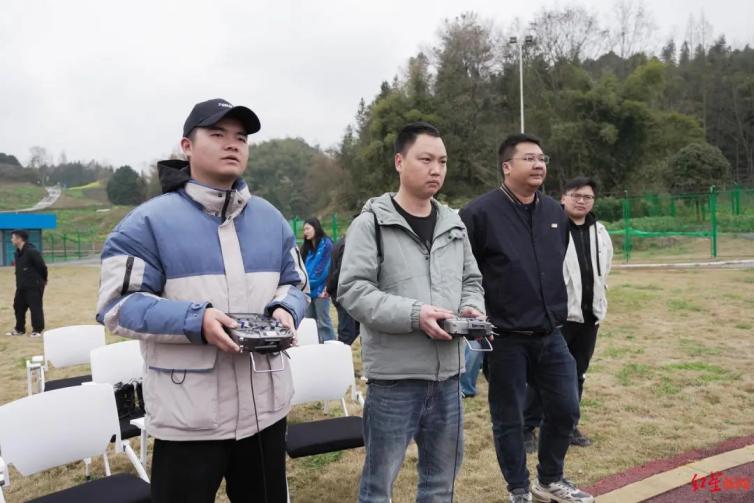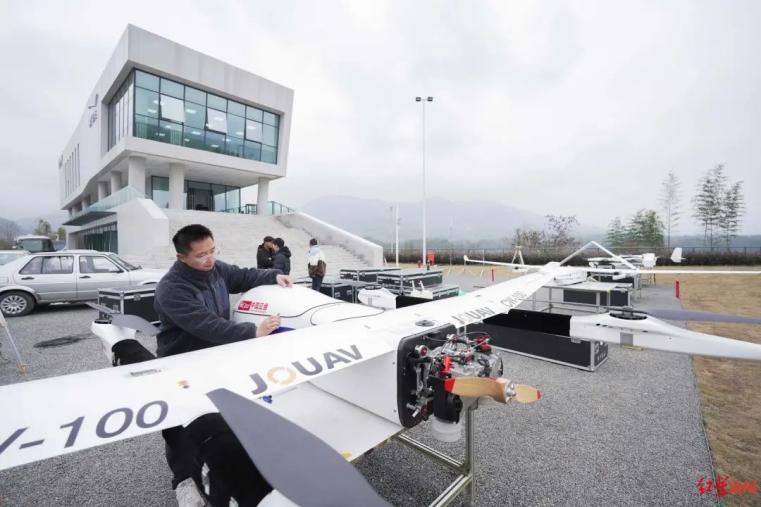Low-altitude economy takes off?in Sichuan's Pengzhou

Drones are displayed at the Chinese national civil unmanned aerial vehicle (UAV) testing base "Sky Eye" in Pengzhou, southwest China's Sichuan province.
In Guihua township of Pengzhou, southwest China's Sichuan province, the air hums with the sound of drones. Unmanned aerial vehicles (UAVs) of various types and sizes are a constant presence in the skies - hovering, gliding, and maneuvering. This township is home to the Chinese national civil UAV testing base - known as "Sky Eye."
Located in the northwestern corner of the Chengdu Plain, Pengzhou spans elevations from 489 meters to 4,814 meters above sea level. This vast elevation range creates a unique topographical environment, offering an expansive and versatile testing environment for advancing the low-altitude economy.
Currently, "Sky Eye" features 10 functional areas, including those for test flights, countermeasure validation, and communications, along with 19 distinct test scenarios. The facility has attracted 145 enterprises and research institutions, ranking it first among China's 20 national UAV testing bases in terms of the number of facilities and testing scenarios.
Notably, "Sky Eye" pioneered a nationwide reform in airspace management, shifting from pre-approvals to a streamlined notification system. Previously, UAV test flights required applications seven working days in advance. Now, only a 30-minute advance filing is necessary. This substantial reduction in processing time has significantly accelerated project implementation. Since this reform, the base has recorded more than 200 flights per day on average, with airspace utilization efficiency increasing by over fivefold.

A drone certification training session is held at the Chinese national civil unmanned aerial vehicle (UAV) testing base "Sky Eye" in Pengzhou, southwest China's Sichuan province.
Leveraging the cluster of drone-related enterprises, Pengzhou is also actively enhancing its capabilities in low-altitude security, aiming to build an integrated management platform that facilitates surveillance, target identification, and countermeasure operations across low-altitude airspace.
Among the resident enterprises at "Sky Eye" is Shenzhen Naijie Electronic Technology Co., Ltd. When company head Chen Wei first visited Pengzhou, the base was still in its early stages. However, he was immediately attracted by its diverse topography, flexible airspace, and high frequency of test flights. Within just one week, he completed site registration and testing preparations.
Through continuous innovation and technological advancements, the company developed a multispectral electro-optical tracking system. By integrating multispectral imaging with intelligent recognition, the system can continuously monitor small, slow-moving, and low-altitude targets such as drones within a 3-to-5 kilometer radius - ideal for urban security and major event protection. "In these mountain valleys, we do not just test products; we realize our dreams," Chen noted.
In recent years, Pengzhou has evolved from testing services to full industrial integration, establishing local manufacturing and R&D facilities. The city launched China's first "4S store" for drones, providing services on drone sales, maintenance, parts and information. This facility enables enterprises to purchase a full range of drones and counter-surveillance products, order customized solutions for specific applications, and conduct immediate on-site testing - all within a single location.
Recognizing talent as foundational, Pengzhou established the first batch of drone training schools in southwest China. These institutions offer certification programs, skills training, and public education. In collaboration with institutions such as the University of Electronic Science and Technology of China and the Civil Aviation Flight University of China, the city has built practical training platforms that have already trained over 3,000 skilled professionals nationwide.

A staff member checks a drone at the Chinese national civil unmanned aerial vehicle (UAV) testing base "Sky Eye" in Pengzhou, southwest China's Sichuan province.
Drones are now being deployed across an expanding range of sectors in Pengzhou, including logistics, emergency response, infrastructure inspection, public services, and law enforcement.
In December 2024, villagers in Yaojia village, Pengzhou's Bailu township received their first "airborne delivery." An automated drone completed a delivery that previously required 40 minutes by road in just eight minutes. This "sky courier" system has enhanced mail delivery efficiency in mountainous areas by more than 80 percent. So far, Pengzhou has established 50 low-altitude logistics stations in its mountainous regions, with over 6,000 drone delivery flights completed since January 2024.
In emergency rescue scenarios, drones are proving especially valuable. In February, a landslide struck Luping neighborhood in Guihua township. A drone, operating on a preset patrol route, promptly detected the incident. Equipped with thermal imaging and gas sensors, it accurately located trapped individuals. In geological disaster early warning and forest fire prevention, the city's integrated "air-ground-space" emergency response system has improved hazard detection efficiency by 80 percent.
"There remains significant untapped potential for drone applications. We will continue to deepen our 'drone-plus' strategy, expand application scenarios, and vigorously develop the low-altitude economy," said an official from Pengzhou's low-altitude economy office.
(Photos courtesy of Red Star News)
Photos
Related Stories
- Low-altitude industry readies for takeoff
- Low-altitude economy set to take off
- World highest altitude swimming race to kick off in NW China
- Tibet to build world's highest-altitude airport in 2012
- Mountaintop symphony provides high culture at highest altitude
- Tibetan genes adapted to high altitude, study finds
- Nyingchi launches 'non-altitude sickness' tourist route
- Denmark reopens airspace above 11 km altitude
- World's highest-altitude airport planned on Tibet
Copyright © 2025 People's Daily Online. All Rights Reserved.









